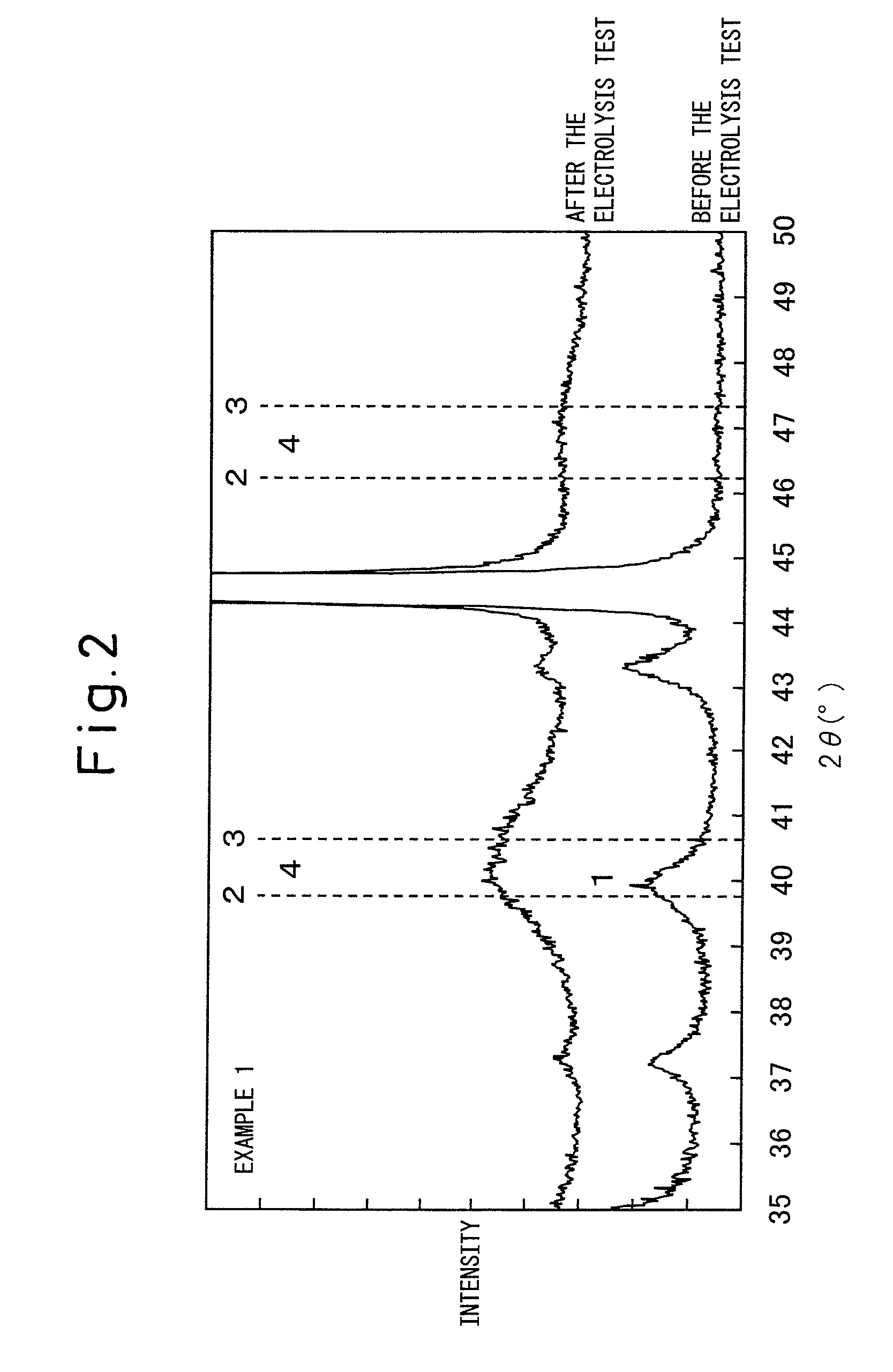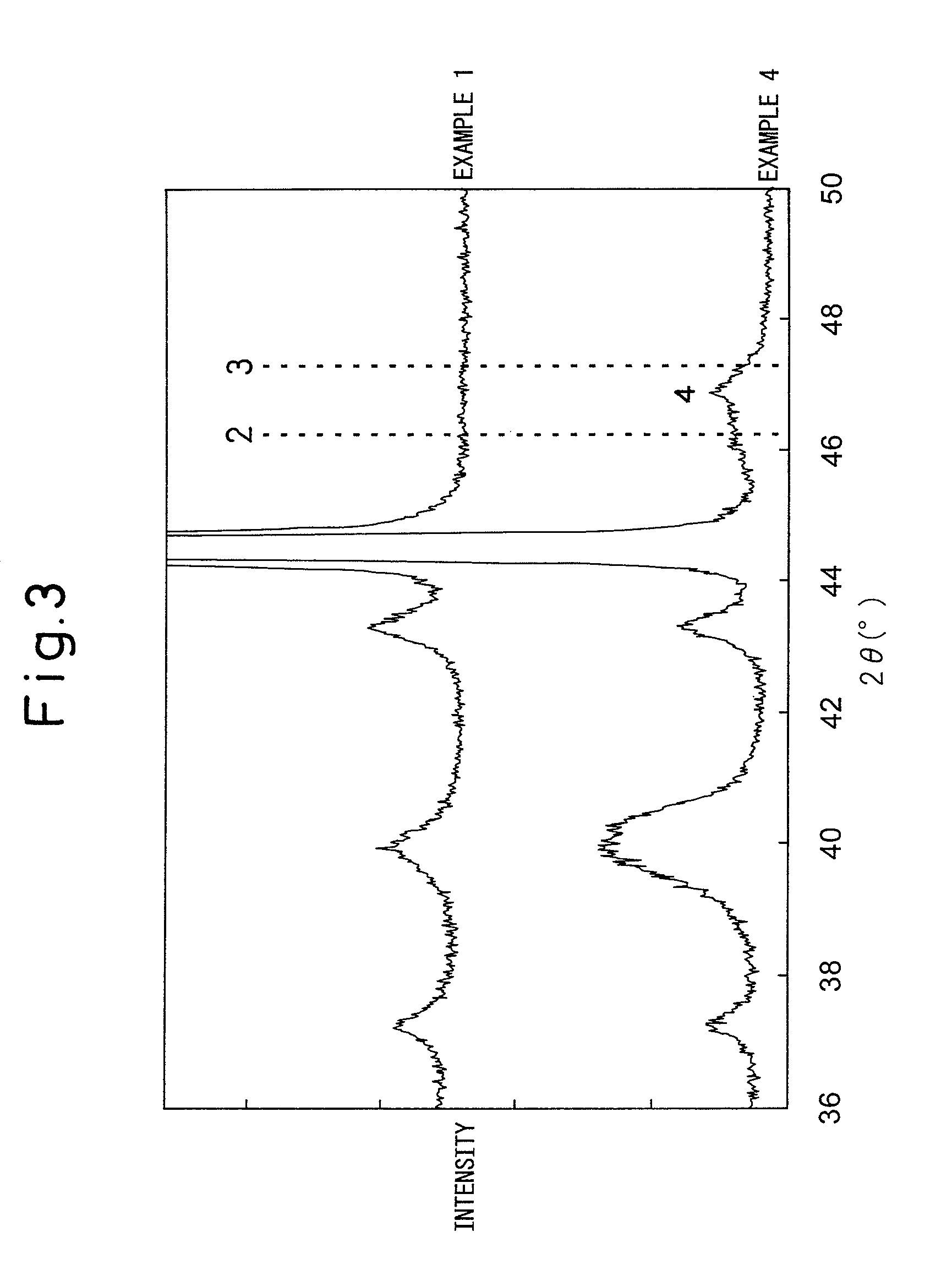Cathode for hydrogen generation and method for producing the same
a cathode and hydrogen generation technology, applied in the direction of electrolyte coatings, cell components, manufacturing tools, etc., can solve the problems of reducing the operation method of the electrolyzer, the reduction of the electrolytic voltage, and the reduction of the energy consumption of the electrolyte, so as to achieve the effect of superior durability and low hydrogen overvoltag
- Summary
- Abstract
- Description
- Claims
- Application Information
AI Technical Summary
Benefits of technology
Problems solved by technology
Method used
Image
Examples
example 1
[0092]As the conductive base material, a woven mesh base material which was made by knitting a nickel fine wire having a diameter of 0.15 mm in a sieve mesh size of 40 was used. The conductive base material was blasted with alumina powder having a weight average particle size of 100 μm or less, then subjected to an acid treatment in 6N hydrochloric acid at room temperature for 5 minutes, followed by rinsing with water and drying.
[0093]Subsequently, an application liquid was prepared by mixing a dinitrodiammineplatinum nitric acid solution (produced by Tanaka Kikinzoku Kogyo K.K., platinum concentration: 100 g / L) and an iridium chloride solution (produced by Tanaka Kikinzoku Kogyo K.K., iridium concentration: 100 g / L) so that a molar ratio of platinum to iridium became 0.27:0.73.
[0094]A vat including the application liquid was placed in the lowest part of the coating roll, and the application liquid was impregnated into the coating rolls made of EPDM. A roll was placed above the vat ...
example 2
[0099]An electrode was prepared and evaluated in the same way as in Example 1, except that an application liquid was prepared by mixing a dinitrodiammineplatinum nitric acid solution (produced by Tanaka Kikinzoku Kogyo K.K., platinum concentration: 100 g / L) and an iridium chloride solution (produced by Tanaka Kikinzoku Kogyo K.K., iridium concentration: 100 g / L) so that a molar ratio of platinum to iridium became 0.4:0.6.
[0100]In the X-ray diffraction peaks before the electrolysis test (FIG. 1), the peak of iridium oxide can be clearly observed whereas a clear peak of metal platinum cannot be observed. From this, it can be understood that the catalyst layer before the electrolysis test is composed of crystalline iridium oxide and amorphous platinum. In addition, the full width at half maximum of the X-ray diffraction peak) (2θ=34.70° of iridium oxide was 0.42°. Similarly to in Example 1, it can be understood that iridium-platinum alloy had been formed from the X-ray diffraction peak...
example 3
[0102]A cathode was prepared and evaluated in the same way as in Example 1, except that the cathode was subjected to the thermal decomposition at 470° C. for 10 minutes, and further subjected to the post-heat treatment at 470° C. for 1 hour after the thermal decomposition.
[0103]In the X-ray diffraction peak (FIG. 1) before the electrolysis test, the clear peak of iridium oxide can be observed whereas a clear peak of metal platinum cannot be observed. From this, it can be understood that the catalyst layer before the electrolysis test is composed of crystalline iridium oxide and amorphous platinum. In addition, full width at half maximum of the X-ray diffraction peak (2θ=34.70° of iridium oxide was 0.46°. Furthermore, similarly to as in Example 1, it can be understood that iridium-platinum alloy had been formed from the X-ray diffraction peaks after the electrolysis test.
[0104]As shown in Table 1, as a result of the salt electrolysis test by the ion-exchange membrane process, the hyd...
PUM
| Property | Measurement | Unit |
|---|---|---|
| 2θ | aaaaa | aaaaa |
| temperature | aaaaa | aaaaa |
| temperature | aaaaa | aaaaa |
Abstract
Description
Claims
Application Information
 Login to View More
Login to View More - R&D
- Intellectual Property
- Life Sciences
- Materials
- Tech Scout
- Unparalleled Data Quality
- Higher Quality Content
- 60% Fewer Hallucinations
Browse by: Latest US Patents, China's latest patents, Technical Efficacy Thesaurus, Application Domain, Technology Topic, Popular Technical Reports.
© 2025 PatSnap. All rights reserved.Legal|Privacy policy|Modern Slavery Act Transparency Statement|Sitemap|About US| Contact US: help@patsnap.com



